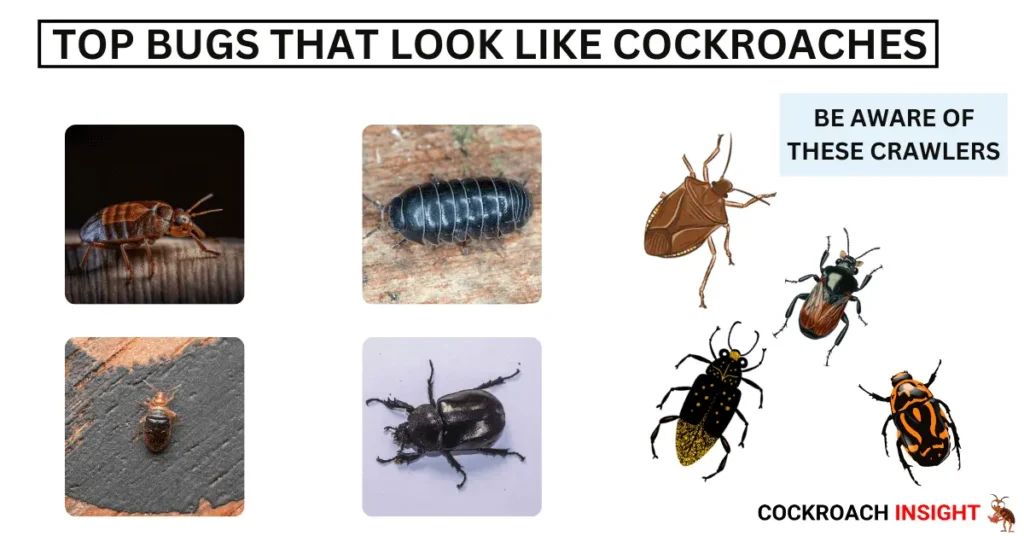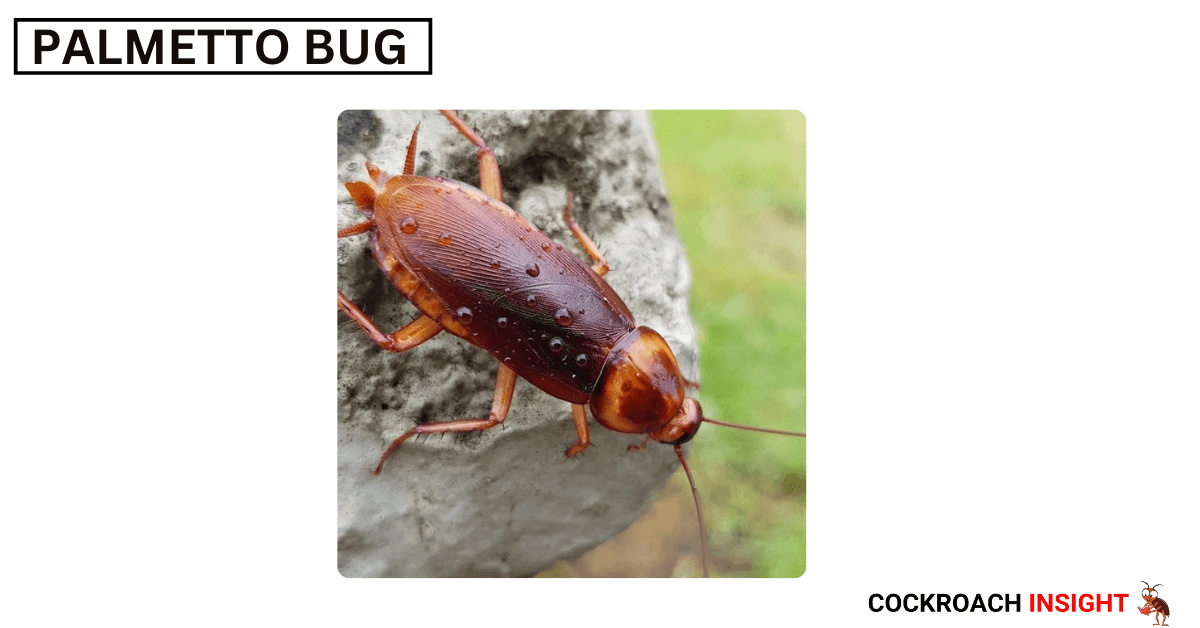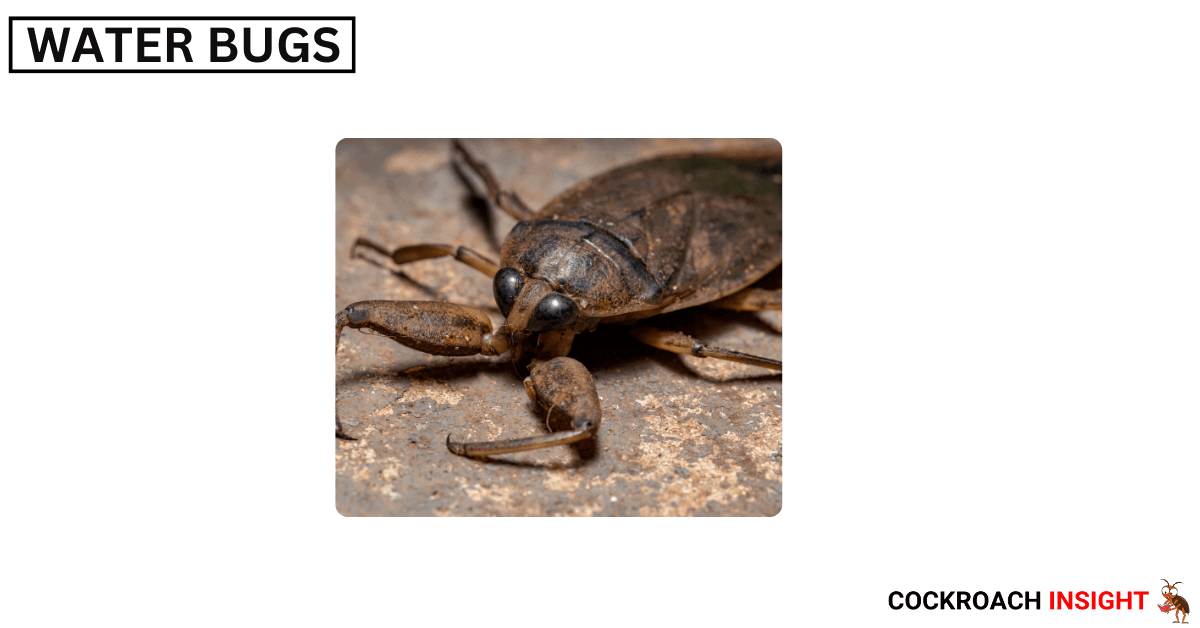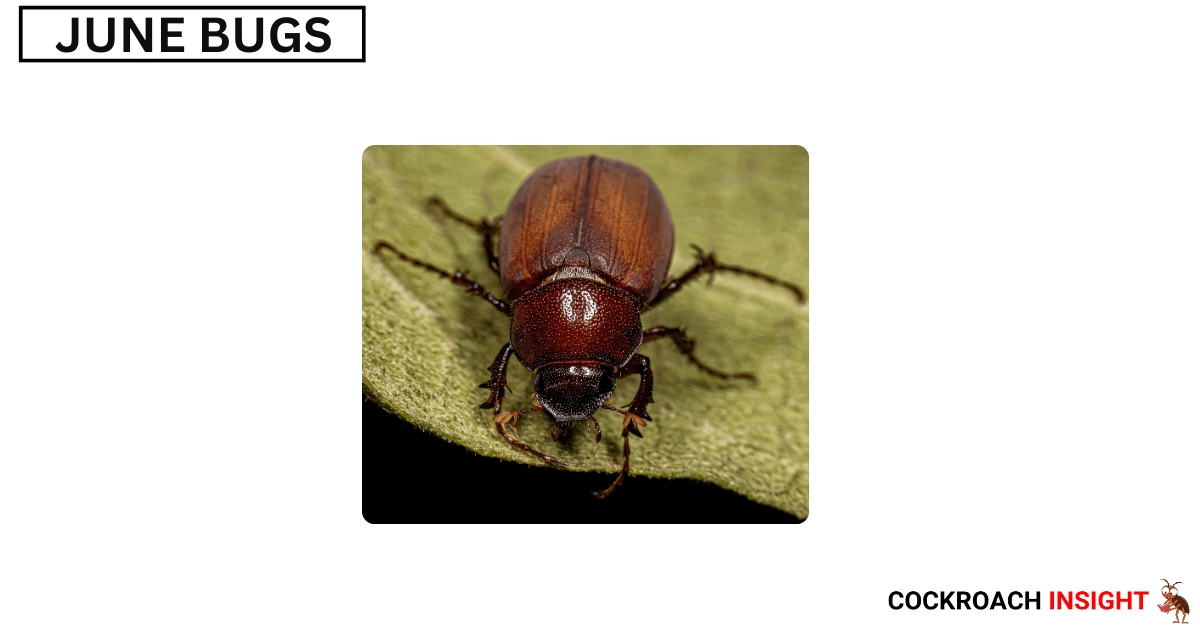Have you ever seen a fast moving bug at home and felt your heart race thinking it is a cockroach? I’ve been there myself. Something about that dark, skittering shape can make anyone uneasy.
However, not all the bugs that look like cockroaches are actually ones! In reality, many common bugs will have many of the same characteristics, and this can cause needless anxiety and sometimes even lead to an expensive pest control call.
Here, I’ll give you ways to be sure of these cockroach impostors, and ways to keep them from invading your home. This guide also transforms you into a confident insect identifier.
We will cut through the confusion, equipping you with the essential knowledge and visual codes to distinguish common reaches look-alikes from the real one. With a little knowledge, you can avoid the stress of mistaken identity and even adapt your space nicely.
The imposters: Common Cockroach Look-Alike
Some bugs look like cockroaches, and it’s easy to confuse them. them due to their size, colour or general appearance. This section provides detailed profiles of the most common look-alikes, highlighting their key differences.
Because they are so large and dark, Palmetto bugs are often confused with cockroaches. In fact, these bugs are a kind of cockroach, and they are especially common in humid regions. In addition, water bugs and palmetto bugs can also sometimes be confused and can cause disguised worry.
Water Bugs
Water bugs are very similar to cockroaches, but you usually find them closer to moist areas like ponds, drains, and sewers. Generally, they’re larger and have thicker bodies, thicker antennas, and bigger eyes.
They don’t usually live in homes as cock roaches do, but it is good to know the difference between water bugs and cockroaches.
June Bugs
June bugs are more rounded and can be drawn to outdoor lights but may wander inside. Often, their shape and lack of quick hiding behavior separate them from cockroaches. These bugs are harmless, but they can startle you when you believe them to be indoor cockroach infestations.
Crickets
Of course, when people see crickets indoors, they can be alarmed by their dark color and rapid, quick movements. But they are separated in appearance from cockroaches due to their long hind legs and chirping sounds.
Ground Beetles
Ground beetles are about the same size, same color, and look similar but don’t have the flexible, almost rubbery exoskeleton. While most are found in gardens, their shape and slower movement can help set them apart from cockroaches.
I had seen what I presumed was a cockroach on the kitchen floor until I saw that it had long hind legs and chirped. This is how I recognized these small details and, therefore had to avoid unnecessary worry!
Palo Verde Beetles
Palo Verde beetles are large, scary beetles that look similar to cockroaches and are often mistaken for cockroaches because they are dark and not good looking.
These beetles are native to the southwestern United States, where they can be found close to Palo Verde trees because their larvae actually feed on those tree roots.
Whereas Palo Verde beetles are slow-moving and are seen out and about only during summer months, especially following rain. They may seem scary, but these beetles are not dangerous to humans and don’t enter homes like cockroaches.
Flour Beetles
They are much smaller, with a slender reddish brown body, but we can still be confused with cockroach nymphs (juveniles) by their similar coloration.
Flour beetles are stored mainly in food pantries or areas where food is stored and eat grains and other dry foods product.
Flour beetles are not nocturnal, and unlike cockroaches they won’t scurry away quickly Keeping food stored in airtight containers can help prevent flour beetle infestations.
May Beetles
May beetles, also known as June bugs in some regions, are chunky, brown or black beetles that can be mistaken for cockroaches at a glance. They like light and are usually seen outside during the late spring and early summer.
Unlike cockroaches, May beetles are clumsy fliers and often bump into walls and windows.
They don’t breed indoors and do not infest homes; they may occasionally wander inside because they are attracted to lights.
Side-by-Side Comparison Table Cockroaches Vs. Look-Alikes
Bug Comparison Table
| Bug Type | Shape | Color | Behavior | Habitat |
|---|---|---|---|---|
| Cockroaches | Flat, oval | Brown to black | Nocturnal, quick to hide | Indoors, warm, dark spaces |
| Water Bugs | Oval, bulkier | Dark brown to black | Slower, bolder | Near water sources, drains |
| June Bugs | Round, compact | Brown to green | Attracted to lights, clumsy fliers | Outdoors, near lights |
| Crickets | Slim, long hind legs | Dark brown to black | Chirping, jumps when disturbed | Outdoor grassy areas, occasionally indoors |
| Ground Beetles | Hardened, segmented body | Black to dark brown | Slow-moving | Outdoors, gardens, and soil-rich areas |
Though cockroaches and bugs that resemble them can be challenging to tell apart, it’s a lot easier if you pay attention to a few details.
Body Shape and Size
Cockroaches typically have a flat, oval-shaped body to hide in tight spaces. They’re so distinct in shape that they can slip through the tiniest cracks effortlessly.
Other species of cockroaches can get up to 2 inches long, but most are between 1 to 2 inches in size. June bugs and beetles, for example, are many lookalike bugs that, unlike many resembling bugs, possess rounder or more cylindrical bodies that don’t compress similarly.
Color
Some cockroaches are brown to black, but some are reddish or amber. For example, the very light tan German cockroaches have two dark stripes along their backs and the very dark brown or black Oriental cockroaches.
If you look closely, many of these cockroach lookalikes have more of a reddish-brown color to them, and that can help you tell them apart from the real thing.
Antennae
Cockroaches are easy to identify, mainly through antennae. Their antennae are long and straight, about equal to the body length.’ The thin, highly sensitive antennae help them respond to movement and perceive their surroundings.
Bugs like beetles often have shorter, thicker antennae that don’t extend as far, making this an effective detail to observe when distinguishing cockroaches from their lookalikes.
Wings
Not all cockroach species fly, but many have flat-winged individuals lying on their backs. Species with the American cockroach have wings that are generally longer than their bodies.
Bugs, like ground beetles or cigarette beetles, with smaller wings or no wings at all, have made it easier compared to their flies. Moreover, cockroaches rarely fly, whereas many beetles can; instead, cockroaches use their wings to glide, as opposed to other beetles that may fly.
Legs
Although they have six spiny legs for speed, they’re built for speed, and they can quickly scurry across surfaces. But their legs are often topped by small bristles, which help both grip and movement.
Other lookalikes, like crickets, may get six legs, but their back legs are bigger and stronger, so they can jump rather than crawl quickly. Cockroaches, on the other hand, have legs that are much shorter and sturdier and are, therefore, faster and more rapid than beetles.
Habitat Preferences: Indoor vs. Outdoor
Indoor cockroaches are like warm and dark places, such as the kitchen cabinets or the basement cabinets. Usually water bugs that look like a cockroach stay around moisture outside or near drains.
Like cockroaches, crickets may sometimes roam indoors, but should remain open or grassy places rather than hidden ones.
Behavioral Traits
But they are nocturnal, moving swiftly to get away from the light and generally hard to spot for long.
Water bugs, which look like cockroaches but actually aren’t, tend to be slower and bolder, whereas crickets make chirping sounds and open distinct hopping motions. The unique behaviors these can demonstrate can let you know if it’s really a cockroach.
I can still remember seeing a cockroach-looking bug near the bathroom sink. I suspected its slow pace and slightly larger size, so I noticed it more closely. It turned out to be a water bug, so no worries there.
3 Small Bugs That Could Fool You for Cockroaches
Not all cockroaches look large; some of the small ones can be confused with bugs as well. Here are four tiny cockroach lookalikes to watch for:
Cigarette Beetles
Cigarette beetles are small light brown beetles that look like cockroach nymphs at a glance. These pests will ‘hide’ in stored food and tobacco products and feed on dried plant material.
Cockroach nymphs are different from the behavior of cigarette beetles, which have rounded bodies and can fly. Sealing and storing food items properly can keep cigarette beetles out of your food items.
Drugstore Beetles
Drugstore beetles resemble the color and size of cigarette beetles, and can be reddish brown in color and humpbacked in shape.
On dry goods like flour, spices, and even pet food, these are easy to confuse with cockroach nymphs in the pantry.
Unlike the cockroaches, however, drugstore beetles don’t run quickly, and have a smooth, hard body. These beetles can be avoided if proper food storage is being done.
Woodlice
Pill bugs, also known as roly-polies or woodlice, are small, crudely oval, covered with a segmented exoskeleton that may resemble a cockroach at a distance.
They roll into a ball when threatened, and they’re usually greyish brown. Unlike cockroaches, woodlice prefer damp, dark outdoor conditions and aren’t a threat indoors.
They can enter homes looking for moisture, but these bugs are fairly easy to tell apart from the other bugs by their armoured look and slow speed.
Beyond Appearance: Behaviour Cues for Identification
Most of the time, behavior is a dead giveaway. If startled, cockroaches will move swiftly and hide; bugs like crickets will chirp and, when disturbed, will similarly hop around.
Movement Patterns:
Observing how an insect moves, where it’s found, and its activity patterns can be just as crucial as its physical appearance for accurate identification. Pay close attention to the insect’s gait.
Cockroaches are known for their incredibly fast, jerky, and erratic
scurrying, often disappearing into cracks with surprising speed. Water bugs are usually less fast and skittish than cockroaches, many beetles, while fast, move in a more direct or lumbering manner. Crickets, of course, are characterized by their distinct hopping.
Flight vs. Gliding Abilities
The ability to fly and glide is also helpful to determine the difference between roach and bugs because many adult cockroaches have wings, not all species are strong flyers; some may glide or only fly short distances.
Beetles have hardened wing covers (elytra) that protect their delicate flight wings underneath. Observe if the insect flies readily, glides, or doesn’t fly at all. This observation provides clear sight to distinguish them.
Living Preferences and Time of Day
Living preferences and appearance time are also great sources of identification because roaches have different preferences compared to look-alikes. The location where you find the bug can provide vital clues.
Cockroaches prefer dark, secluded, warm, and moist areas (e.g., behind refrigerators, under sinks, in basements, inside cabinets) and are mostly active at night.
Finding a large, dark insect in broad daylight in the middle of your living room might indicate it’s not a cockroach, but rather an outdoor insect that wandered in (like a ground beetle).
Activity Time: Note if the bug is active during the day or night. This helps rule out nocturnal pests like cockroaches if you consistently see the bug during daylight hours.
By seeing these behavioural differences, it’s easier for you to recognize bugs that look like cockroaches but aren’t.
Necessary Tools for the Pest Detective:
You don’t need a professional lab to identify a bug. These simple tools can
significantly aid your observation and documentation to identify the pest, either a roach or a look-alike roach.
Magnifying Glass/Jeweler’s Loupe:
For close examination of small features like antennae, leg spines, and body segmentation. A magnifying glass/Jeweler’s loupe is
helpful to examine tiny features of the pest.
Smartphone Camera (with macro mode or good zoom):
Capturing with a pest camera provides detailed photos from multiple angles. This is invaluable for later comparison with online resources or sharing with experts.
Clear Jar or Container with a Lid:
You can also observe a pest by tapping it in a clear jar or container for safe capture and observation of the insect without direct contact or harming it.
Entomology Field Guides/Apps:
Different guides and applications are also
available to compare the features of pests. For example, Reputable resources (e.g., university extension apps, reputable insect identification apps) for cross-referencing and further identification.
Gloves and Tweezers:
Must use gloves if you come into direct contact with pests and
work with tweezer for safe handling of insects, especially if you’re unsure of their identity or if they might bite.
Flashlight: Use a flashlight to to illuminate hidden areas (under appliances, inside cabinets) or observe nocturnal insects without disturbing them too much.
Post Identification Action: Your Next Step
Once you’ve identified the insect, knowing what to do next is crucial. Your response will depend on whether you’ve found a harmless look-alike or a confirmed cockroach.
If It’s a Harmless Look-Alike
If you found that it’s not a roach but a look-alike roach, don’t panic immediately. Many insects are harmless compared to roaches. Follow the following tips if you find a harmless pest.
Safe Removal:
Safely remove them from a surface or place where you found
them. For most accidental invaders (like ground beetles or stink bugs), simply
scoop them up and release them outdoors.
Prevention:
While harmless, their presence might indicate easy entry points. Review the prevention tips below to minimize future unwelcome visitors. Because through these entry points, roaches may enter, so preventive measures are necessary.
Expert Tip: Avoid crushing unidentified bugs. Some bugs can release foul odors (e.g., stink bugs) or allergens (e.g., certain beetles) when crushed.
If It’s a Confirmed Cockroach
While finding a cockroach is concerning, take immediate action, but don’t panic. Anxiety makes it difficult to eliminate because relaxation is key to successfully
accessing and eliminating a roach.
Assess Severity:
Assess the severity of infestation, whether it is a small infestation or a large one, which is further helpful to deciding the elimination process.
One or two sightings: Could be a stray, but also a sign of a small, developing problem.
Multiple sightings, especially during the day: Strong indicator of a larger, established infestation.
Initial Steps for Small Infestations:
Intensify Sanitation: Immediately clean thoroughly, eliminate food crumbs, and seal food in airtight containers.
Eliminate Water Sources: Fix leaky faucets, wipe down sinks, and don’t leave standing water.
Seal Entry Points: Caulk cracks and crevices in walls, around pipes, and behind cabinets.
Use Traps: Sticky traps can help monitor activity and catch individual roaches.
When to Call a Professional:
Persistent sightings: If you continue to see cockroaches despite your
best efforts.
Signs of a large infestation: Many roaches, roaches seen during the
day, droppings, or egg cases.
Health concerns: If family members have allergies or asthma
exacerbated by pests.
This advice is unbiased and focused on empowering the reader with appropriate next steps, whether DIY or professional, based on the severity of the situation.
Preventive Tips to Avoid Bugs and Cockroaches in Your Home
If you’re keeping cockroaches and looking like roaches out of your home, then it can be as simple as these tried-and-true prevention strategies.
Seal Entry Points
Pests find entry into your home through small cracks and gaps around doors, windows, and floors. Seal even the tiniest of openings with caulk and weather-stripping; bugs such as water bugs and crickets can sneak through gaps that
you might think as being too small.
From a pest control perspective, if possible, check vents and pipes, particularly bathrooms, kitchens where moisture can attract pests, for added protection.
Store Food Securely
Excess food is something that attracts cockroaches and other pests. As eating bug food can attract the wrong sort of bug, store dry goods like grains and pet food in
airtight containers.
Don’t let food sit out on counters, clean up crumbs and spills immediately. That means this practice greatly decreases the chances of seeing bugs that resemble a
cockroach in your kitchen.
Maintain Cleanliness
Keeping your home clean is a good way to deter bugs. Regular vacuuming and mopping — especially in hard-to-reach areas — will prevent food particles that may
attract roaches.
You also won’t want to neglect cleaning under appliances and furniture, as these darker and more undisturbed spaces are where bugs find refuge.
Also, trash bins should have secure lids that are regularly empty.
Control Indoor Humidity
Cockroaches like to live in humid areas, so reducing the dew points of your house can repel them. If rooms are damp, use dehumidifiers in damp areas, such as basements, bathrooms, and laundry areas.
Fix any leaky pipes or faucets, as water sources attract bugs that look like cockroaches but aren’t, such as water bugs.
Limit Outdoor Lighting
June bugs are drawn to light and may enter your home if they’re attracted to bright outdoor lighting, and there are many bugs.
Insects don’t like yellow tinted lights so if you can switch those that will help, or take the bright lights away from the entrances. For example, this simple change can
minimize your bug encounters indoors.
Once I sealed off entry points and sliced the humidity out of my bathroom I found that by far the most unexpected bugs. Making small changes to daily habits has made my home feel clean and secure from pests.
Conclusion and Decision Guidance
You might be able to tell that it’s not a cockroach when you see it, but a little education can help because these lookalikes are stressful. You know what to look for (shape, behavior, and habitat) and can avoid needless panic and pest control calls.
Self motivate yourself to see first, because many bugs like crickets or water bugs are simply cockroaches mistaken for harmful.
If you want to understand more about how to stop pests coming into your home, check out our how to keep cockroaches out of drains and other natural deterrent range.
Using these tools in your hand you will be more confident and better able to protect your home from pests. Sometimes, if you see the occasional bug, it isn’t an indication of an infestation!
FAQ SECTION
Is there a cockroach that’s a bug?
Yes, many bugs look like cockroaches and include water bugs, ground beetles, June bugs, and crickets. Often, these bugs have other bugs with the same colour, which creates confusion.
Can cockroaches look like bed bugs?
Not exactly. Within their respective groups there are similar looking bed bugs and cockroaches, but bed bugs are generally smaller and more rounded while cockroaches are more flatter and a bit longer.
What is the difference between a roach and a cockroach?
They are also just known as ‘Roach’ which translates to ‘cockroach’, so they are basically the same thing. But “water roach” often does not refer to cockroaches, as they’re known, but to water bugs.
How can you tell the difference between a roach and a water bug?
Cockroaches like dark indoor spaces and water bugs are generally larger and tend to be near water. Water bugs also crawl less fast and are less jumpy than cockroaches.
Can cockroaches fly, and do they have wings?
True, some cockroach species do have wings and can fly short distances, but not all cockroach species are good at flying.















